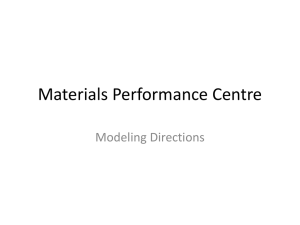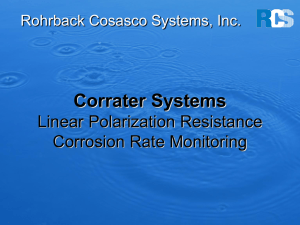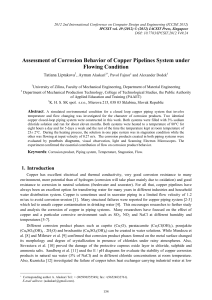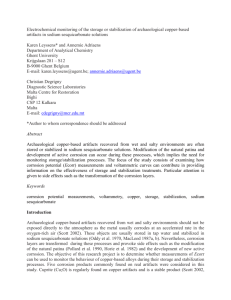"There is a general misconception that copper will not corrode in
advertisement
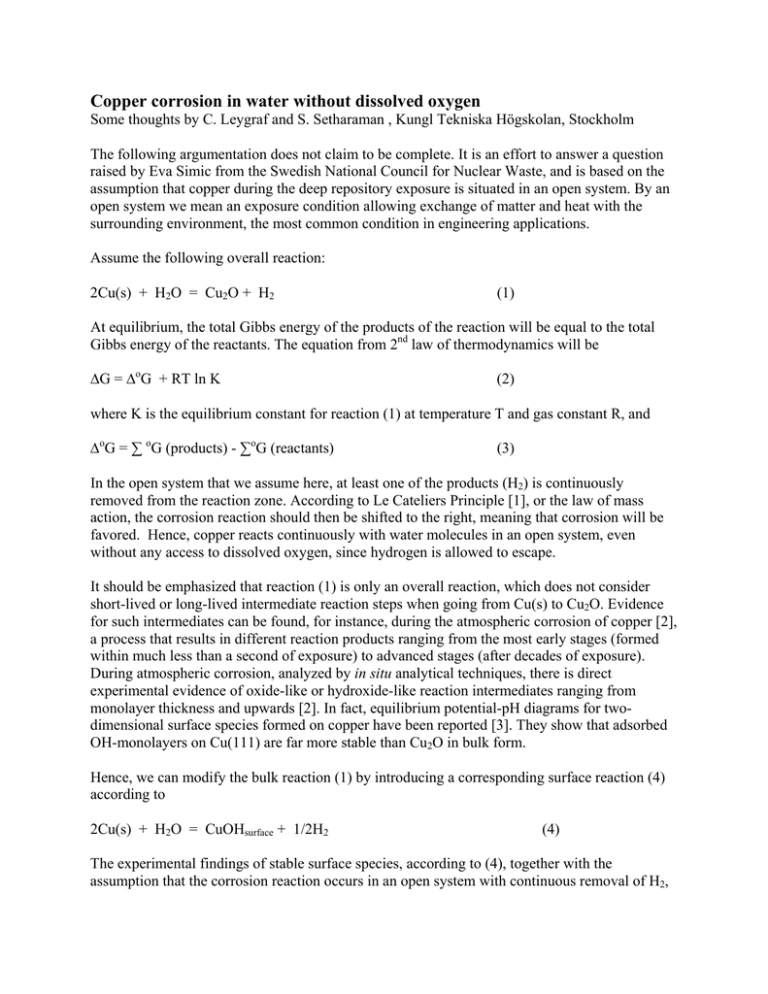
Copper corrosion in water without dissolved oxygen Some thoughts by C. Leygraf and S. Setharaman , Kungl Tekniska Högskolan, Stockholm The following argumentation does not claim to be complete. It is an effort to answer a question raised by Eva Simic from the Swedish National Council for Nuclear Waste, and is based on the assumption that copper during the deep repository exposure is situated in an open system. By an open system we mean an exposure condition allowing exchange of matter and heat with the surrounding environment, the most common condition in engineering applications. Assume the following overall reaction: 2Cu(s) + H2O = Cu2O + H2 (1) At equilibrium, the total Gibbs energy of the products of the reaction will be equal to the total Gibbs energy of the reactants. The equation from 2nd law of thermodynamics will be ∆G = ∆oG + RT ln K (2) where K is the equilibrium constant for reaction (1) at temperature T and gas constant R, and ∆oG = ∑ oG (products) - ∑oG (reactants) (3) In the open system that we assume here, at least one of the products (H2) is continuously removed from the reaction zone. According to Le Cateliers Principle [1], or the law of mass action, the corrosion reaction should then be shifted to the right, meaning that corrosion will be favored. Hence, copper reacts continuously with water molecules in an open system, even without any access to dissolved oxygen, since hydrogen is allowed to escape. It should be emphasized that reaction (1) is only an overall reaction, which does not consider short-lived or long-lived intermediate reaction steps when going from Cu(s) to Cu2O. Evidence for such intermediates can be found, for instance, during the atmospheric corrosion of copper [2], a process that results in different reaction products ranging from the most early stages (formed within much less than a second of exposure) to advanced stages (after decades of exposure). During atmospheric corrosion, analyzed by in situ analytical techniques, there is direct experimental evidence of oxide-like or hydroxide-like reaction intermediates ranging from monolayer thickness and upwards [2]. In fact, equilibrium potential-pH diagrams for twodimensional surface species formed on copper have been reported [3]. They show that adsorbed OH-monolayers on Cu(111) are far more stable than Cu2O in bulk form. Hence, we can modify the bulk reaction (1) by introducing a corresponding surface reaction (4) according to 2Cu(s) + H2O = CuOHsurface + 1/2H2 (4) The experimental findings of stable surface species, according to (4), together with the assumption that the corrosion reaction occurs in an open system with continuous removal of H2, favors the corrosion of copper in water, even without any dissolved oxygen gas. Similar to what is observed in atmospheric corrosion, one may expect that the surface species with time gradually transforms into a more three-dimensional reaction product of type Cu2O. It should be noted that this thermodynamic analysis does not give any information on the rate at which the reaction proceeds, e.g. of copper corrosion in water without dissolved oxygen. Reported values of copper corrosion rates were in the range 1-10 µm per year in copper cooling systems in generators for electric production and in particle accelerators, despite the fact that active measures were taken with respect to water treatments in order to minimize the corrosion [4]. Furthermore, literature reviews show that all published corrosion rates of copper in municipal or distilled water are roughly in the range of 1-25 µm per year and 15-250 µm per year in salt containing neutral waters [5, 6]. Even if these exposure conditions of copper are far from the conditions during the deep repository exposure, they nevertheless show that evidences for reported copper corrosion rates below 1 µm per year seem very difficult to find. In all, we conclude that the statement that copper corrodes in water without dissolved oxygen does not violate any thermodynamic principles, and we also notice that copper corrosion rates slower than 1 µm per year are hard to find under any exposure condition . References: [1] D. R. Gaskell, “Introduction to Metallurgical Thermodynamics of Materials”, Third edition, Taylor & Francis, 1995. [2] C. Leygraf and T.E. Graedel, “Atmospheric corrosion”, John Wiley & Sons, New York, 2000 [3] E. Protopopoff and P. Marcus, Electrochim. Acta, 51 (2005) 408 [4] SSM-report 2009/2636 [5] F.L La Que and H.R. Copson, “Metals and Alloys”, American Chemical Society Monograph Series, 2nd edition, Reinhold, New York, 1963. [6] http://www.corrosionist.com/copper_pipe_corrosion.htm


